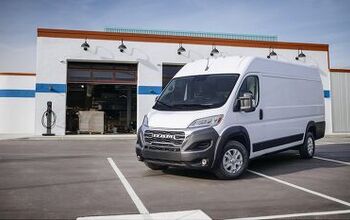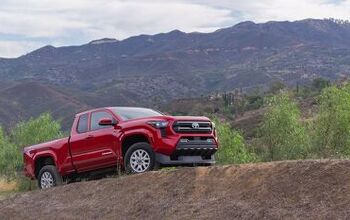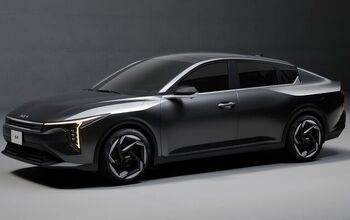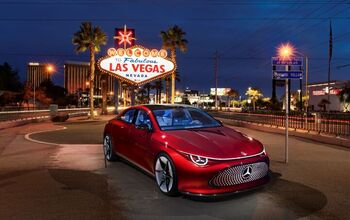2010 GMC Terrain SLT-2 Review

The GMC Terrain may be a compact crossover, but it has all the bold and brawny styling of a Mack truck, with boxy flared fenders and a massive front grille. A sister vehicle to the Chevrolet Equinox, it certainly doesn’t look it.
FAST FACTS
| 1. Sharing a platform with the Chevy Equinox, the GMC Terrain gets the same engine choices, a 182-hp 4-cylinder or a 264-hp V6. |
| 2. Fuel economy for front-drive 4-cylider models is rated at 22/32 mpg (city/hwy) and 17/25 mpg for the V6 front-drive |
| 3. Cargo room is rated at 31.6 cu.-ft. or 63.9 cu.-ft. total |
| 4. Pricing starts at $24,250, with our SLT-2 FWD 4-cylinder tester starting at $29,550. |
Now we criticized the Equinox for its large look, as we worried compact crossover customers might ignore it. Conversely, we love the Terrain’s manly and muscular appearance, as we’re convinced a traditional CR-V owner wouldn’t ever think of buying a GMC.
REBIRTH OF GMC: AN OLD PLAN WITH A NEW TWIST
General Motors has a new plan for the GMC brand and it’s so crazy it might just work. The concept, it seems, is to rebrand and restyle Chevys as GMCs. Now, we know what you’re thinking… didn’t they do that with Saturn and Pontiac and isn’t that what got them into a financial mess?
The short answer is yes.
The difference with GMC, however, is that the idea of bringing muscular styling from middle-America to new models designed more for the big cities on the coasts, might just work. And this bold styling is sure to be a big draw with younger buyers who might not have considered a GM product of any sort, until now.
What also makes this plan different from rebadging Chevys as Pontiacs is the fact that GM is actually producing pretty decent vehicles these days.
POWERFUL AND EFFICIENT 4-CYLINDER, BUT TRANSMISSION HAS ISSUES
Case in point, the Terrain’s engine. In front drive layout and with GM’s direct-injection 2.4-liter 4-cylinder, GMC claims a best-in-class highway fuel economy rating of 32-mpg, with a city rating of 22-mpg. During our test we managed 25-mpg, which is pretty incredible for a vehicle with room for five and good cargo room.
Power from the 4-cylinder is rated at 182-hp and 174 ft-lbs of torque. Many journalists have complained that this isn’t enough, perhaps forgetting that it is in fact a compact crossover and not a real truck. We, however, think the acceleration is adequate and would only opt for the V6 for towing purposes – the V6 rated to tow 3,500 lbs vs. the 4-Cyl at 1,500 lbs. Costing just $1,500 extra for the V6, it’s certainly attractive, although you’ll spend far more in the long run in fuel, with a rating of 17/25 mpg. Plus, once you’ve opted for the six, you’ll be tempted to go for the then-optional 19-inch wheels.
Unfortunately, GMC doesn’t seem to have worked out all the issues with the Hydra-Matic 6T45 six-speed transmission setup. We had no problems with this tranny in the Equinox we tested recently, but in the Terrain it exhibited numerous problems, seemingly of the electronic variety. The transmission was slow to go into gear and when cold stuttered when asked to go from reverse to drive, taking far too long to actually initiate the gear. We noticed that quite often when pulling away from a stop, if we lifted off the gas and then got back on it, the tranny would also hesitate, as though confused at what to do. And in another instance, when stopped on a slight incline leaving the office parking lot we went to put the truck into reverse to allow a pedestrian to pass in front, only to have the tranny hesitate again and the truck roll forward. Lucky we were quick on the brakes and avoided rolling into the woman, who was oblivious to the situation.
GMC definitely needs to make some adjustments to either the transmission or the transmission control unit.
LOOKS BIG BUT DRIVES SMALL
In regards to driving dynamics, the Terrain does seem to be tuned more for a truck-like driving feel, with a bit more lean in the corners than some competitors. For the most part though, the suspension is identical to that in the Equinox, although the Terrain has a slightly wider track as well as slightly better ground clearance with a minimum height of 7.8-inches (although the same overall height). The turning radius also remains constant with its Chevy twin.
As big as the Terrain looks, it’s no behemoth and we found it quite easy to scoot around in – even in urban traffic. In fact, it will fit nicely into a single garage space, even though you wouldn’t expect it to.
Overall, the driving feel is reasonably sporty for a crossover, but the Terrain continues to feel more like a mid-size crossover than a compact one – which is at least in keeping with its look.
There’s also a truck-like build quality to the Terrain, with doors that slam shut with a resounding thud.
WELL-APPOINTED AND EXECUTED INTERIOR
Another strong point for the Terrain is its interior. While fully optioned-out models have plenty of style with two-tone leather and the like, all come nicely designed and put together. The monotone black leather on our tester isn’t the best combo for looks, but was still nice. And like the Equinox, you just don’t expect red stitching on the seat and dash on a vehicle at this price-point – something that really helps it stand out.
Even more impressive is when the dash lights up at night, with a bright red glow. There’s even red ambient lighting for the center console and cupholder surrounds. We still find the center stack a bit excessive in the button department, but we have to commend GM for the digital trip display between the gauges that not only gives plenty of info, but can also display the car’s speed digitally.
In the rear seat area there’s a notable absence of style, with big swaths of hard plastic on the doors. But considering the use the rear seats area will get, it’s at least purposeful. Like the Equinox, the Terrain gets GM’s MultiFlex rear bench seating that can slide forwards and back by 8-inches. Even when forward legroom is good and when pushed all the way back, there’s a tremendous amount of space to stretch out. This is aided by the Terrain’s huge rear doors that make accessing those seats easy.
The sliding rear seats also allow for different amounts of rear cargo room. With the seats all the way forward, the Terrain offers 31.6 cubic feet of space and when folded flat, there’s a total of 63.9 cu.-ft. That’s good, but not exactly great, falling far short of the class-leading Honda CR-V, despite the Terrain’s huge appearance. One much-appreciated luxury feature that comes on the SLT-2 trim level is a power liftgate for easy access to your cargo.
The SLT-2 trim level includes most every feature you could ask for with the usual power options plus leather, heated front seats and an 8-way power driver’s seat with lumbar support and a memory setting. There’s also automatic climate control, an impressive 8-seaker audio system with a subwoofer and 7-inch display screen, rear parking assist, heated mirrors, remote vehicle entry and vehicle start, Bluetooth connection, a sunroof and a leather steering wheel with audio controls and cruise controls. Like we said, pretty much everything.
We’re not really sure if the seat memory is really necessary, but some customers will most likely see the appeal and it’s obvious GM wants to market the Terrain as a bit of a step-up from the Equinox. That’s why models like the SLT-2 also come with gobs of chrome on the exterior and some big and bright 18-inch wheels.
With the Terrain starting at $24,250 it’s definitely priced higher than a lot of compact crossovers, allowing GMC to target it against larger models like the Nissan Murano, Ford Edge and Mazda CX-7, even thought it’s really more of a CR-V, RAV4 rival. Our SLT-2 tester in front-drive 4-cylinder form starts at $29,550 and thanks to a $2,145 Navigation system, a few small options and a very reasonably priced $1,295 rear seat entertainment system with two display screens its sticker price is $33,035 (deliver included).
THE VERDICT
The Terrain is likely just the first of many new vehicles for the GMC brand, using a smart new strategy. Priced at several thousand over its Chevy Equinox twin, it’s putting much needed cash in GM’s pockets. The down side to this smart business model is that the customer has to pay extra.
Most customers aren’t likely to mind, however, as there’s a real feeling that you’re getting more with the Terrain, with its bold style and big looks that make even the pricey $24,250 base price seem like a bargain compared to larger vehicles.
The reality, however, is that it’s still a compact crossover and, when judged on those qualities alone, it excels. There’s good cargo room and great passenger room, top-notch fuel economy, a nicely executed interior and overall sturdy GMC construction. Price is a drawback and the transmission issues are definitely worrisome.
With the Terrain, GMC has built a highly competitive compact crossover that snubs it big chrome grille at conventionally cute ‘utes.
RELATED READING
2009 Honda CR-V
2009 Toyota RAV4
2008 Ford Escape Review
2010 Chevrolet Equinox 1LT AWD Review
2009 Volkswagen Tiguan
2010 Hyundai Tucson: First Drive
2009 Mitsubishi Outlander
2008 Nissan Rogue SL AWD Review
2010 Mazda CX-7 i Sport Review
2009 Subaru Forester 2.5X Review
2009 Ford Edge
2009 Toyota Venza Review
2009 Nissan Murano
2009 Dodge Journey SE Review
2009 Mercury Mariner
2009 Jeep Patriot Review
LOVE IT
- Muscular looks
- Fuel economy
- MultiFlex seating
LEAVE IT
- Transmission issues
- Pricey for a compact crossover

With AutoGuide from its launch, Colum previously acted as Editor-in-Chief of Modified Luxury & Exotics magazine where he became a certifiable car snob driving supercars like the Koenigsegg CCX and racing down the autobahn in anything over 500 hp. He has won numerous automotive journalism awards including the Best Video Journalism Award in 2014 and 2015 from the Automotive Journalists Association of Canada (AJAC). Colum founded Geared Content Studios, VerticalScope's in-house branded content division and works to find ways to integrate brands organically into content.
More by Colum Wood

















![2011 Kia Sportage Review [Video]](https://cdn-fastly.autoguide.com/media/2023/06/26/06062/2011-kia-sportage-review-video.jpg?size=350x220)













Comments
Join the conversation